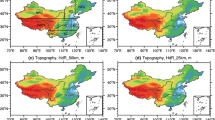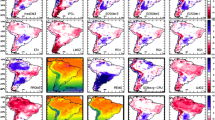Abstract
Climate change in the 21st century over China is simulated using the Abdus Salam International Centre for Theoretical Physics (ICTP) Regional Climate Model version 3 (RegCM3). The model is one-way nested within the global model CCSR/NIES/FRCGC MIROC3.2_hires (Center for Climate System Research/National Institute for Environmental Studies/Frontier Research Center for Global Change/Model for Interdisciplinary Research on Climate). A 150-year (1951–2100) transient simulation is conducted at 25 km grid spacing, under the Intergovernmental Panel on Climate Change Special Report on Emissions Scenarios (IPCC SRES) A1B scenario. Simulations of present climate conditions in China by RegCM3 are compared against observations to assess model performance. Results show that RegCM3 reproduces the observed spatial structure of surface air temperature and precipitation well. Changes in mean temperature and precipitation in December–January–February (DJF) and June–July–August (JJA) during the middle and end of the 21st century are analyzed. Significant future warming is simulated by RegCM3. This warming becomes greater with time, and increased warming is simulated at high latitude and high altitude (Tibetan Plateau) areas. In the middle of the 21st century in DJF, a general increase of precipitation is found in most areas, except over the Tibetan Plateau. Precipitation changes in JJA show an increase over northwest China and a decrease over the Tibetan Plateau. There is a mixture of positive and negative changes in eastern China. The change pattern at the end of the century is generally consistent with that in mid century, except in some small areas, and the magnitude of change is usually larger. In addition, the simulation is compared with a previous simulation of the RegCM3 driven by a different global model, to address uncertainties of the projected climate change in China.
Article PDF
Similar content being viewed by others
Avoid common mistakes on your manuscript.
References
IPCC. Climate Change 2007: The Physical Science Basis. In: Solomon S, Qin D, Manning M, et al., eds. Contribution of Working Group 1 to the Fourth Assessment Report of the Intergovernmental Panel on Climate Change. Cambridge, United Kingdom and New York: Cambridge University Press, 2007. 1–18
Giorgi F. Simulation of regional climate using a limited area model nested in a general circulation model. J Clim, 1990, 3: 941–964
Christensen J H, Hewitson B, Busuioc A, et al. Regional Climate Projections. In: Solomon S, Qin D, Manning M, et al., eds. Climate Change 2007: The Physical Science Basis. Contribution of Working Group 1 to the Fourth Assessment Report of the Intergovernmental Panel on Climate Change. Cambridge, United Kingdom and New York: Cambridge University Press, 2007. 847–940
Hirakuchi H, Giorgi F. Multiyear present-day and 2xCO2 simulations of monsoon climate over eastern Asia and Japan with a regional climate model nested in a general circulation model. J Geophys Res, 1995, 100: 21105–21125
Gao X J, Zhao Z C, Ding Y H, et al. Climate change due to greenhouse effects in China as simulated by a regional climate model. Adv Atmos Sci, 2001, 18: 1224–1230
Gao X J, Shi Y, Song R Y, et al. Reduction of future monsoon precipitation over China: Comparison between a high resolution RCM simulation and the driving GCM. Meteorol Atmos Phys, 2008, 100: 73–86
Jiang D B, Wang H J, Lang X M. Multimodel ensemble prediction for climate change trend of China under SRES A2 scenario (in Chinese). Chin J Geophys, 2004, 47: 776–784
Gao X J, Pal J S, Giorgi F. Projected changes in mean and extreme precipitation over the Mediterranean region from a high resolution double nested RCM simulation. Geophys Res Lett, 2006, 33: L03706
Zhou T J, Yu R C. Twentieth century surface air temperature over China and the globe simulated by coupled climate models. J Clim, 2006, 19: 5843–5858
Ju L X, Wang H J, Jiang D B. Simulation of the Last Glacial Maximum climate over East Asia with a regional climate model nested in a general circulation model. Palaeogeogr Palaeoclimatol Palaeoecol, 2007, 248: 376–390
Xu Y, Gao X J, Giorgi F, et al. Upgrades to the REA method for producing probabilistic climate change predictions. Clim Res, 2010, 41: 61–81
Yu E T, Wang H J, Sun J Q. A quick report on a dynamical downscaling simulation over china using the nested model. Atmos Oceanic Sci Lett, 2010, 3: 325–329
Wang H J, Yu E T, Yang S. An exceptionally heavy snowfall in Northeast China: Large-scale circulation anomalies and hindcast of the NCAR WRF model. Meteorol Atmos Phys, 2011, 113: 11–25
Giorgi F, Marinucci M R, Bates G T. Development of a second-generation regional climate model (RegCM2). Part I: Boundary-layer and radiative transfer processes. Mon Weather Rev, 1993, 121: 2794–2813
Giorgi F, Marinucci M R, Bates G T, et al. Development of a second-generation regional climate model (RegCM2). Part II: Convective processes and assimilation of lateral boundary conditions. Mon Weather Rev, 1993, 121: 2814–2832
Pal J S, Giorgi F, Bi X Q, et al. The ICTP RegCM3 and RegCNET: Regional climate modeling for the developing world. Bull Amer Meteorol Soc, 2007, 88: 1395–1409
Kiehl J, Hack J, Bonan G, et al. Description of the NCAR Community Climate Model (CCM3). NCAR Technical Note, NCAR/TN-420 STR. 1996
Zeng X, Zhao M, Dickinson R E. Intercomparison of bulk aerodynamic algoriths for the computation of sea surface fluxes using toga coare and tao data. J Clim, 1998, 11: 2628–2644
Holtslag A, de Bruijin E, Pan H L. A high resolution air mass transformation model for short-range weather forecasting. Mon Weather Rev, 1990, 118: 1561–1575
Pal J S, Small E E, Eltahir E. Simulation of regional-scale water and energy budgets: Representation of subgrid cloud and precipitation processes within RegCM. J Geophys Res, 2000, 105: 29579–29594
Grell G. Prognostic evaluation of assumptions used by cumulus parameterizations. Mon Weather Rev, 1993, 121: 764–787
Fritsch J M, Chappell C F. Numerical prediction of convectively driven mesoscale pressure systems. Part I. Convective parameterization. J Atmos Sci, 1980, 37: 1722–1733
Dickinson R E, Kennedy P J, Henderson-Sellers A, et al. Biosphere-atmosphere transfer scheme (bats) for the ncar community climate model. Technical Report of National Center for Atmospheric Research. 1986
Liu J Y, Liu M L, Zhuang D F, et al. Study on spatial pattern of land-use change in China during 1995–2000. Sci China Ser D-Earth Sci, 2003, 46: 373–384
K-1 Model Developers. K-1 coupled model (MIROC) description. K-1 technical report 1. In: Hasumi H, Emori S, eds. Tokyo: Center for Climate System Research, University of Tokyo. 2004
Lucarini V, Calmanti S, Dell’Aquila S, et al. Intercomparison of the northern hemisphere winter mid-latitude atmospheric variability of the IPCC models. Clim Dyn, 2007, 28: 829–848
Xu C H, Shen X Y, Xu Y. An analysis of climate change in East Asia by using the IPCC AR4 simulations (in Chinese). Adv Clim Changes Res, 2007, 3: 287–292
Xu Y, Gao X J, Shen Y, et al. A daily temperature dataset over China and its application in validating a RCM simulation. Adv Atmos Sci, 2009, 26: 763–772
Xie P P, Yatagai A, Chen M Y, et al. A gauge-based analysis of daily precipitation over East Asia. J Hydrol, 2007, 8: 607–626
Zhang D F, Gao X J, Ouyang L C, et al. Simulation of present climate over East Asia by a regional climate model. J Trop Meteorol, 2008, 14: 19–23
Gao X J, Shi Y, Giogi F. A high resolution simulation of climate change over China. Sci China Ser D-Earth Sci, 2011, 54: 462–472
Tang H Y, Zhai P M. Comparison of variations of surface air temperatures in eastern and western China during 1951–2002 (in Chinese). Chin J Geophys, 2005, 48: 526–534
Jiang D B, Zhang Y, Sun J Q. Ensemble projection of 1–3°C warming in China. Chin Sci Bull, 2009, 54: 3326–3334
Randall D A, Wood R A, Bony S, et al. Climate models and their evaluation. In: Solomon S, Qin D, Manning M, et al., eds. Climate Change 2007: The Physical Science Basis. Contribution of Working Group 1 to the Fourth Assessment Report of the Intergovernmental Panel on Climate Change. Cambridge, United Kingdom and New York: Cambridge University Press, 2007. 589–662
Sun J Q, Wang H J, Yuan W. Spatial-temporal features of intense snowfall events in China. J Geophys Res, 2010, 115: D16110
Giorgi F, Jones C, Asrar G, et al. Addressing climate information needs at the regional level: the CORDEX framework. WMO Bull, 2009, 58: 175–183
Author information
Authors and Affiliations
Corresponding author
Additional information
This article is published with open access at Springerlink.com
Rights and permissions
This article is published under an open access license. Please check the 'Copyright Information' section either on this page or in the PDF for details of this license and what re-use is permitted. If your intended use exceeds what is permitted by the license or if you are unable to locate the licence and re-use information, please contact the Rights and Permissions team.
About this article
Cite this article
Gao, X., Shi, Y., Zhang, D. et al. Climate change in China in the 21st century as simulated by a high resolution regional climate model. Chin. Sci. Bull. 57, 1188–1195 (2012). https://doi.org/10.1007/s11434-011-4935-8
Received:
Accepted:
Published:
Issue Date:
DOI: https://doi.org/10.1007/s11434-011-4935-8




